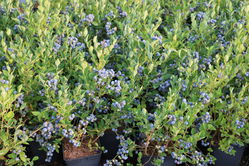 The large-fruited or North American species of blueberry (Vaccinium corymbosum) has been the up-and-coming star among soft fruits for several years, both in global fruit cultivation and in domestic gardens. Although these bog bed plants depend on very special soil conditions, such a location is quite easy to accomplish and even long-term cultivation in a large tubs/containers is largely problem-free. As a result, the demand for plants is uninterrupted, which means that we are regularly sold out of blueberries despite rising production figures.
The large-fruited or North American species of blueberry (Vaccinium corymbosum) has been the up-and-coming star among soft fruits for several years, both in global fruit cultivation and in domestic gardens. Although these bog bed plants depend on very special soil conditions, such a location is quite easy to accomplish and even long-term cultivation in a large tubs/containers is largely problem-free. As a result, the demand for plants is uninterrupted, which means that we are regularly sold out of blueberries despite rising production figures.
The deciduous blueberries
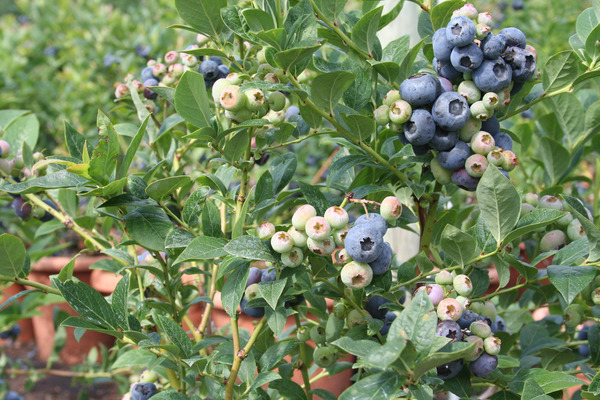
Today's widespread blueberries are mainly varieties of the North American species of blueberries and their crosses, partly also with other Vaccinium species. The deciduous varieties are the result of the group of so-called 'Northern Highbush' plants which are mainly characterized by Vaccinium corymbosum. More interesting is, that also the classically tall varieties of cultivated blueberries usually have a small percentage of Vaccinium angustifolium. This can be traced back to the first blueberry growers at the beginning of the 20th century, who found many low-growing Vaccinium angustifolium in their regions, especially in New Jersey and New Hampshire, in addition to Corymbosum. The compact deciduous varieties then mostly go back to Vaccinium angustifolium and its hybrids.
The compact growing blueberries
Our compact blueberries are suitable for growing in a pot on a balcony or terrace. Due to their compact growth, these varieties take up very little space and therefore do not require such a large container for cultivation. Thus, 20 - 30 litres of soil volume are fully sufficient for the plants to develop well. However, in terms of yield, these varieties do not come close to the fast growing varieties. Rather, they are varieties for snacking.
Lowberry® Little Blue Wonder® – this variety comes from the breeding programme of our sister company Lubera® and convinces with its super compact growth of not more than 50 cm. The very early bloom opens up countless individual flowers and creates an exhilarating impression. The many flowers develop into a multitude of small to medium-sized, sky blue fruits that have a fresh flavour and a fine acidity. In autumn, this variety, like almost all other varieties, convinces with an outstanding autumn colouring.
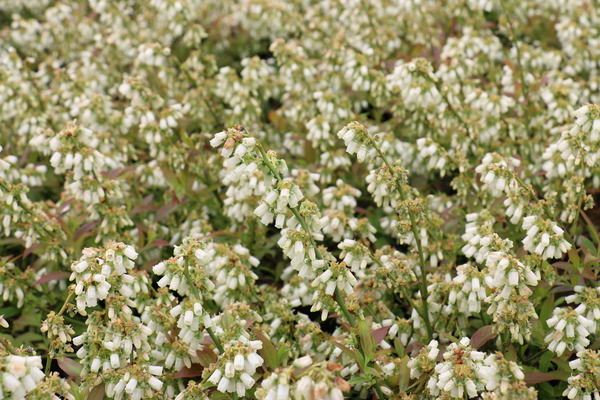
Picture: flowering Lowberry® blueberry Little Blue Wonder®
Hortblue Petite(S) – this variety is also a very compact growing blueberry. It has its origin in New Zealand and convinces by its very beautiful, densely branched growth. The small fruits ripen at the beginning to middle of July. The special feature of this variety begins with the second growth spurt in late summer. When the plants start to grow again in August, this variety also forms new flowers. If the weather is ideal, the fruits of this second bloom will ripen starting in mid-September.
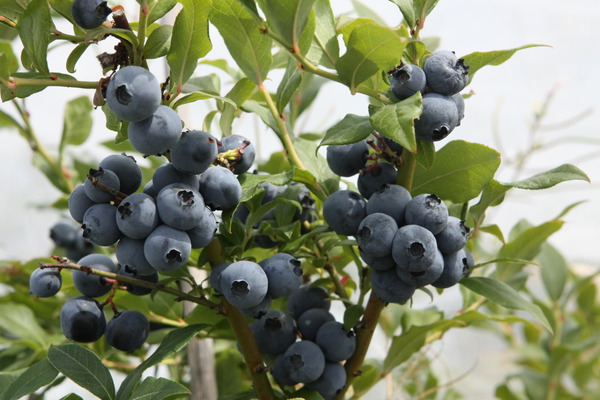
Picture: blueberry Hortblue Petite(S)
The semi-tall growing blueberries
The semi-tall blueberry varieties form shrubs with a height of about 100 cm and have very bushy as well as well-branched growth.
Yelloberry Blue® – this variety is a novelty that will be available as a young plant for the first time in spring 2020. Contrary to the expectations of the variety name, this variety does not form yellow fruits but is characterised by the extraordinary appearance of its yellow leaf colour. In the spring, the plants sprout with copper/bronze-coloured shoot tips. The fully developed leaves then retain an intense dark yellow colour.
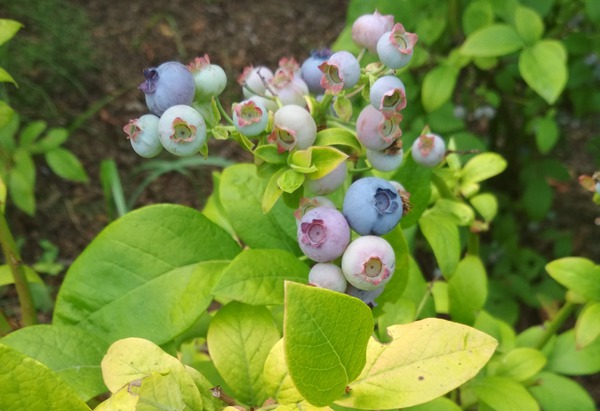
Picture: blueberry Yelloberry Blue® with yellow leafes
Bluesbrothers® – this medium early variety has medium to large fruits. The fruits ripen for a long time from mid/late July to late August/early September. This variety is one of the most nutrient-rich blueberries and it has a very sweet taste with a refreshing acidity. Due to its rather compact and bushy growth, the most compact of the highbush blueberries, this variety is also ideal for growing in containers.
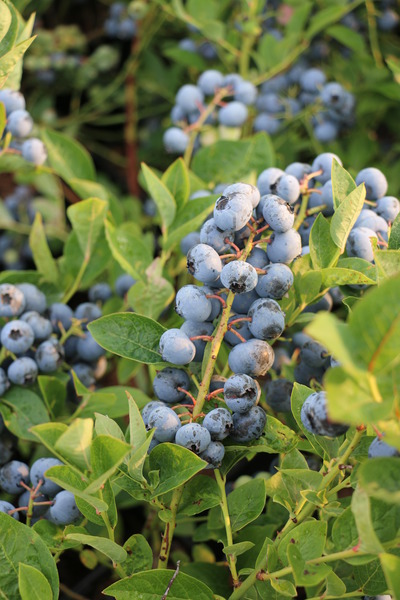
Picture: blueberry Bluesbrothers®
Putte – this medium early variety has small, sweet, bluish black fruits. The compact growth of this variety is due to the crossbreeding of Vaccinium angustifolium.
Emil – Emil is also a cross of Vaccinium corymbosum x Vaccinium angustifolium. Due to this origin, Emil forms semi-tall and multi-branched shrubs. The small fruits are bluish black and they have a very sweet flavour.
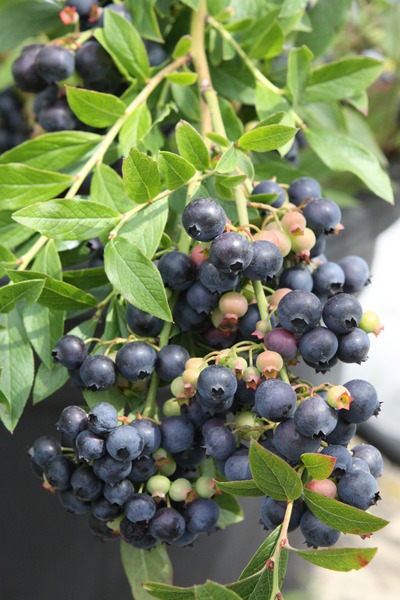
Picture: blueberry Emil
The tall growing blueberries
The varieties in this blueberry group are the classic cultivated blueberries with large, sky blue fruits and a growth height of about 150 - 180 cm.
Cabernet Splash® – this is a new introduction for the 2020 spring season. This exceptional blueberry variety is characterised by its dark red foliage, which changes colour shortly after budding. Paired with the whitish pink flowers, this is a very attractive plant. The blue fruits are mature in August.
Blueroma® (Darrow) – this medium early variety has a very consequent ripening period starting at the beginning of August. The very large and dark blue fruits are characterised by an excellent fruit quality. This variety has a good aroma and a sweet taste with subtle acidity.
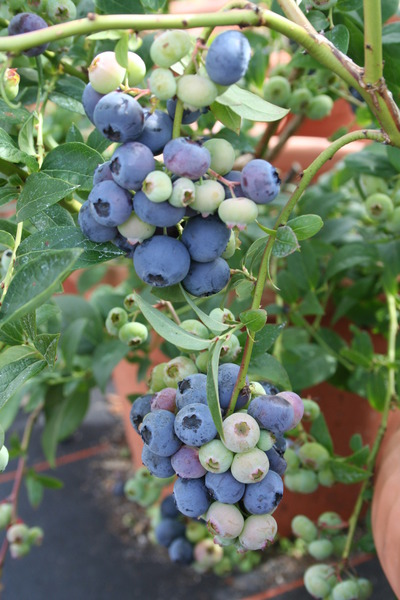
Picture: blueberry Blueroma®
Blue Dessert® (Elisabeth) – this medium late ripening blueberry has large and sweet, aromatic fruits which ripen quite concentrated. The very late flowering protects well against possible late frosts. The plants have a strong, upright and bushy habit.
Bluecrop – this is the classic variety par excellence and it has been a standard variety in fruit cultivation for over 30 years. The large and strongly frosted fruits ripen medium early and they also stay on the shrub for a long time. Due to the consistently high yields, this variety is one of the most successful and reliable blueberry varieties. The fruits have a sweet flavour with a fine acidity but only a moderate aroma.
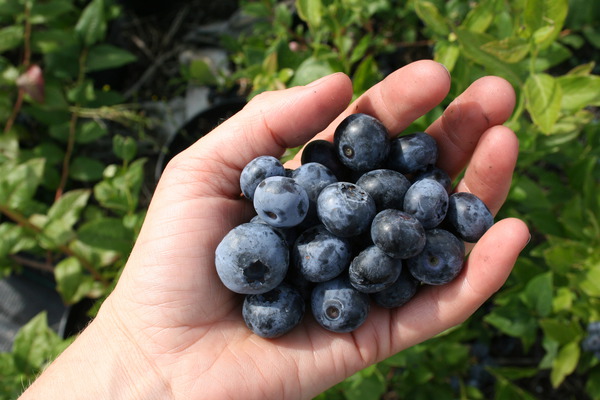
Picture: blueberry Blue Dessert®
Reka® – this is an early ripening variety with strong and upright growth. The sky blue fruits are medium-sized to large and they have a sweet taste with a fine acidity paired with a good aroma.
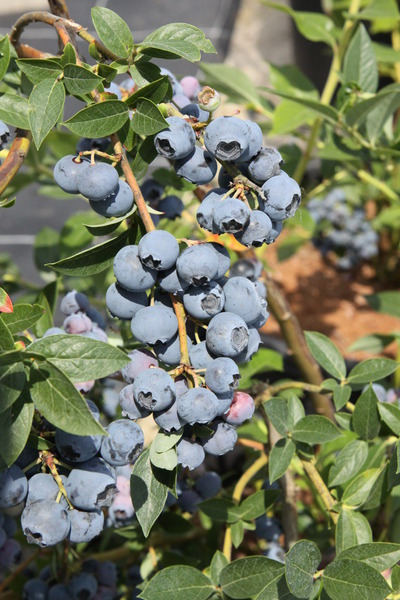
Picture: blueberry Reka(S)
Brigitta Blue – this is a late ripening blueberry variety with a ripening period starting in mid-August. The large and strongly frosted, light blue fruits have an intense aroma and a sweet flavour with a slight acidity.
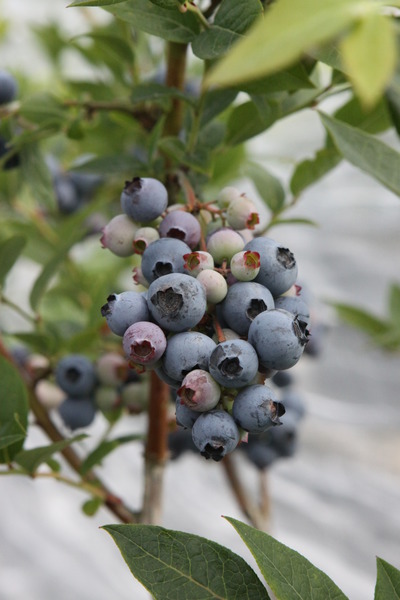
Picture: blueberry Brigitta Blue
Hortblue Poppins(S) – this medium late ripening blueberry variety has medium-sized, sky blue fruits. The fruits taste sweet with little acidity and they have a medium aroma. The special thing about the fruit is its crisp skin, which provides a very pleasant feeling in the mouth when the fruit bursts open after biting.
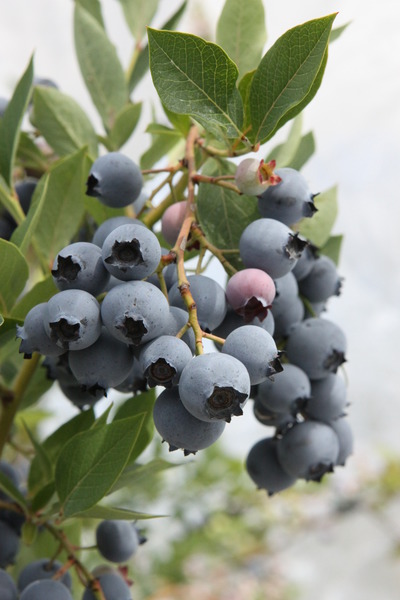
Picture: blueberry Hortblue Poppins(S)
Rubel – this is a medium late variety with small to medium-sized fruits and stiffly upright growth. The fruits have a sweet flavour with a slight but pleasant acidity and a medium aroma. This variety also has a very high content of antioxidants. It convinces with its deep red autumn foliage in autumn.
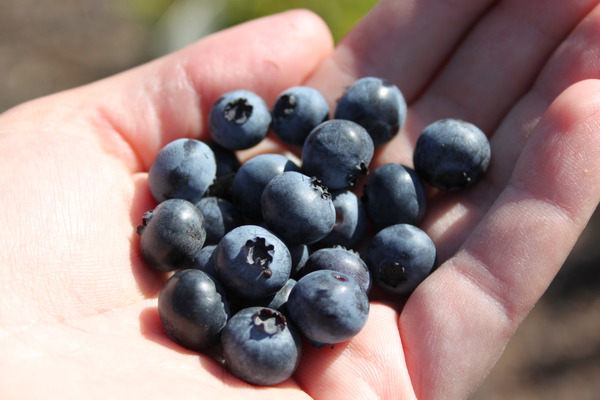
Picture: blueberry Rubel
Patriot – this is a medium early blueberry variety with very large and strongly frosted fruits. The fruits have a good aroma and a sweet taste with a pleasant acidity. The plants have strong, broad upright growth.
Duke – this is the earliest variety in our assortment with a ripening period from the beginning of July and thus about two to four before all other varieties. This variety has very large fruits with a sweet taste and a slight acidity as well as a medium aroma. The plants have strong, upright growth and by nature can renew its wood well.

Picture: blueberry Duke
Wintergreen/semi-evergreen blueberries
The wintergreen and semi-evergreen blueberry varieties are based on crosses between the North American species of blueberry (Vacc. corymbosum or Northern Highbush) and a subtropical Vaccinium species, which is native to the south-eastern part of the United States, hence the term 'Southern Highbush'. The crossbreeding of this subtropical species has the advantage that the varieties have a lower need for cold. On the other hand, there is the disadvantage that these varieties do not have the same winter hardiness as pure Vacc. corymbosum varieties.
The semi-tall growing blueberries
Sunshine Blue – this variety is also characterised by its rather compact and well-branched growth. Through crossbreeding with Southern Highbush genetics, this variety remains almost evergreen, but at least wintergreen, and also has attractive, pink flowers. The ripening period is medium early and lasts from July to August. The medium-sized fruits have an intense flavour with a fine acidity.
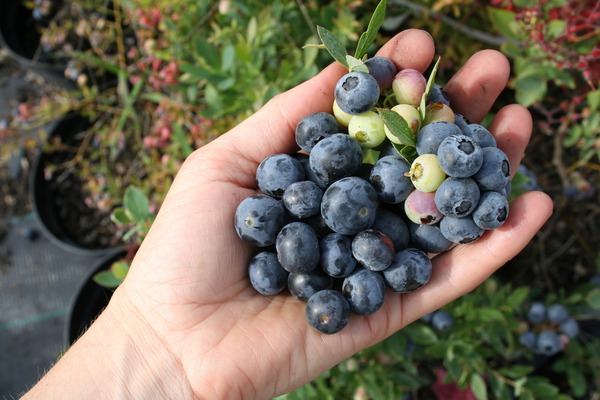
Picture: blueberry Sunshine Blue
The tall growing blueberries
Buddy Blue® (Powder Blue) – this stiffly upright growing variety has silvery frosted foliage and an intense red-yellow colouration in autumn. The fruits are medium in size and are also frosted. They have a good aroma with a clear acidity. Buddy Blue® is the ideal pollination partner for Pink Lemonade®. This variety is evergreen and only loses its old foliage in the following spring as the new shoots appear. This aspect makes the variety more susceptible to winter/frost dryness, especially when it is grown in a container.
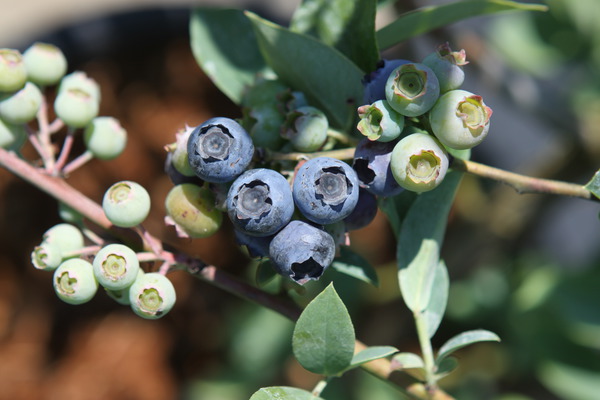
Picture: blueberry Buddy Blue
Pink Lemonade® – this late ripening blueberry has intense pink-coloured fruits that taste very sweet with the typical blueberry aroma. The yields are high, provided that the pollination is right. The blueberry variety most suitable for this is Buddy Blue®. This variety has light green foliage as well as firm and upright growth with good branching. Due to Southern Highbush genetics, Pink Lemonade® is semi-evergreen and therefore more susceptible to winter/frost dryness.
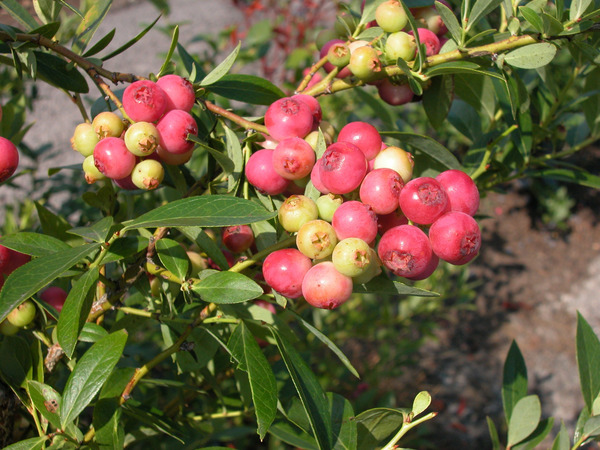
Picture: blueberry Pink Lemonade®
The special blueberries
Again and again, the selection of botanical species leads to random discoveries that turn out to be worth marketing. This is what happened with the variety Blautropf®.
Blautropf® – Botanically speaking, the variety Blautropf® is an independent Vaccinium species (Vacc. cylindraceum). This is also the reason why this variety looks so different. In contrast to the white, mostly cylindrical flowers of the cultivated blueberries, the flowers of Blautropf® have a more trumpet-like shape and they change colour from cream white to an intense red. After flowering, aromatic and tasty fruits are formed. The fruits have a striking teardrop shape; they are dark blue and are frosted only slightly or not at all. The plants have rather compact growth with a somewhat irregular habit and are therefore ideal for growing in containers. When new shoots occur, the young leaves are initially reddish to coppery and then they turn dark green. This variety is evergreen and therefore more susceptible to winter/frost dryness than the deciduous varieties.
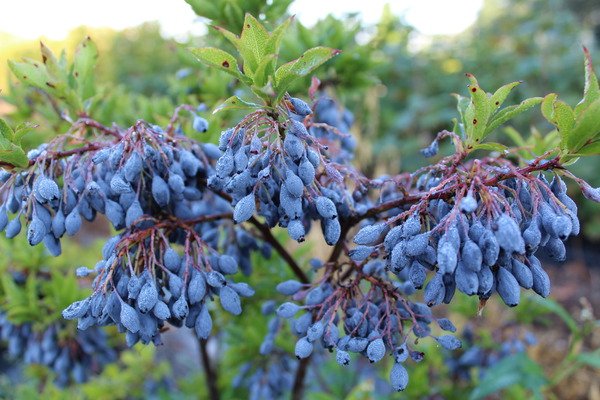
Picture: blueberry Blautropf®
Plants related to blueberries
Not all species of the genus 'Vaccinium' are blueberries. The cranberry or the lingonberry also belong to the same genus and are therefore also mentioned here, as these species are particularly suitable for underplanting a bog bed.
Cranberry(Vaccinium macrocarpon)
Stevens – this is a large-fruited cranberry variety with dark red fruits. The taste of the fresh fruits is very acidic and astringent due to the high content of antioxidants. The long and thin shoots grow flat above the ground and are therefore ideal for underplanting a bog bed. Stevens is very productive and has been one of the main fruit varieties in the United States since the middle of the last century.
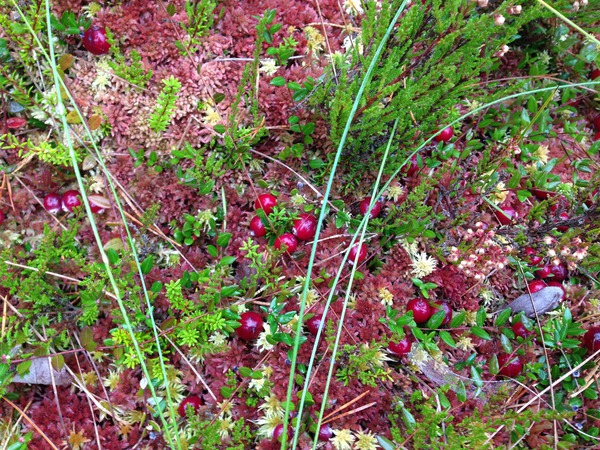
Picture: Cranberry Stevens
Lingonberry (Vaccinium vitis-idea)
Red Pearl – this lingonberry has small to medium-sized, cherry red fruits. In the summer there are numerous whitish pink flowers, from which the sweetish and tangy, aromatic fruits ripen until late summer. The evergreen plants form a dense cushion on the ground and they are only about 25 cm high. Due to this characteristic, the lingonberry Red Pearl is also well suited for underplanting a bog bed.
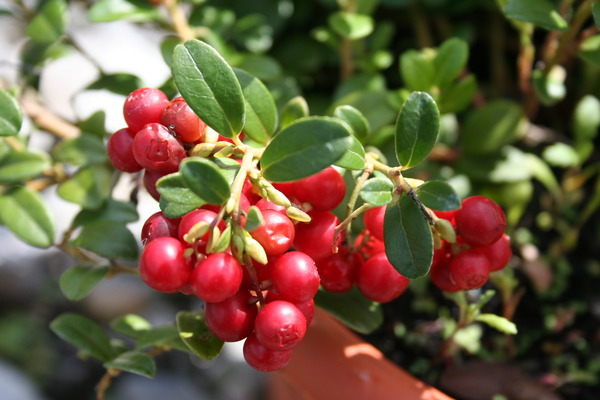
Picture: lingonberry Red Pearl
Click here for more information.
Would you like more information, an individual consultation or information about additional ranges?
Click here for the complete 2019 catalogue, which can be downloaded.
If you have specific questions, please do not hesitate to contact our customer service, where you can also spontaneously place an order.
And of course we are always there for you via telephone.
If you want to be regularly informed about news, etc., you can also subscribe to our gardener newsletter here, which we send out about once a month - it's worth it!
